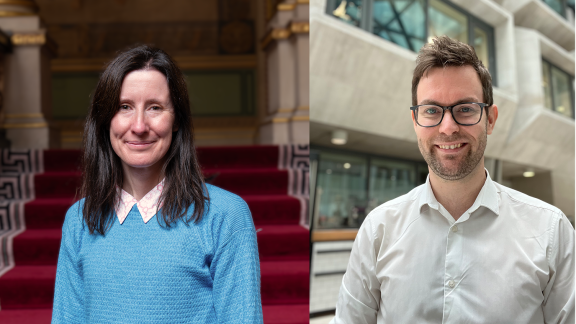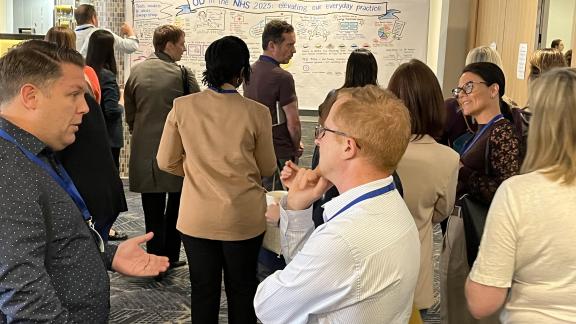Delivering organisational design at scale

Mark Buttanshaw, head of OD&D and continuous improvement at the Ministry of Justice and Karen Clark, OD&D team leader at the Foreign, Commonwealth and Development Office offer a step-by-step guide to delivering organisational design in large, complex organisations.
Where to start with organisation design? It can feel overwhelming when you know the problem you are is facing is fundamental: your organisation isn’t set up to deliver your organisational strategy. Time to roll up the sleeves and start the design process.
A standard organisation design methodology provides a useful container for what, in reality, gets messy very quickly. It keeps you moving forwards on the design journey, even when you’re not quite sure where the work is going to take you.
There are multiple methodologies to choose from. The key is to pick one that works in your context and stick with it. This means you have an approach you can look back to when things inevitably get tricky, and it helps with holding the uncertainty of change when you have a defensible approach grounded in best practice.
The methodologies tend to follow four steps, which we take in turn below. There’s generally some iteration involved and it helps to entwine organisational development (OD) work into the steps as well.
1. Prepare
This is perhaps the most important step and often tempting to rush through. Don’t! Preparation is key. You'll want to know who the decision makers are, how participative they want the process to be and what matters in terms of the design (through creating a set of design principles).
You’ll need to agree the scope of the work and resources, noting that design work in one part of an organisation will inevitably bump into others.
Key activities:
- Identify and meet the key stakeholders involved – this might be a working level contact/s at first, but make sure you also have a conversation with a senior colleague who is the decision maker. If the decision maker is too busy to meet you now, they’ll almost certainly be too busy to meet you in the middle or at the end.
- Make a contract - write a contract document which clearly sets out your expectations for the work and check it matches the expectations of your decision makers. It doesn’t need to be extensive, but it does need to be something which helps you and your stakeholders be clear on what they want from the work.
- Develop design principles - write a set of principles which are the basis for your design. Think of the design principles as the guardrails. You’re specifying what good design looks like and it’s best to lock this down before you start designing.
2. Discover
This step is about understanding the design your organisation is currently operating with. Start with what the work is and explore what currently works and what doesn’t. Your aim will be to alleviate any pain points but keep the aspects that are working well in your new design.
There are lots of ways you might capture this data and you might deliberately integrate this stage with a framework such as Appreciative Inquiry.
Key activities:
- Gather qualitative and quantitative data - you really do need both to understand the organisation from a numerical point of view (number of people, costs, where the data suggests the problems are, etc) and qualitatively understand what’s really going on by involving people through interviews and focus groups.
- Analyse the data - find a way of making sense of the data you’ve gathered and the story it’s telling you and the organisation. You could use SWOT analysis for an easy way to identify the Strengths, Weaknesses, Opportunities and Threats. Or you could use a more specific organiation design tool like the Galbraith Star or the McKinsey 7S.
- Develop a vision (and possibly a purpose/mission) – Write down the organisation’s vision for the future. There might already be one or you might need to articulate a vision statement for the first time. Depending on the context, a purpose statement or mission statement might be useful too; we don’t find you need all three every time.
3. Design
In this step, you’ll want to take what you’ve learned and create several design options, perhaps using an organising logics design tool to help. Remember this is about how best to organise to deliver, so you may want to consider governance arrangements, key processes, boundaries and interfaces, leadership and culture, as well as (or instead of) structures.
It’s also important to take the people out of the design at the start, you’ll get to that in the second half of the design phase.
Key activities:
- Futures thinking - start by looking at mega trends in society and how they might affect the future around your work. It helps to break people out of focusing on the way things currently work and can open up new possibilities and insights.
- Analyse activities - capture the future activities your organisation will need to deliver. Start with the highest level ‘value stream’ of your organisation (the five to eight fundamental steps of activities through which you'll deliver value) then break these down into sets of activities beneath each step. Test these against current activities to check if you’ve missed anything and the key points of change you’ll need to pay attention to.
- Draw out design options - look at the ways you might logically group the activities you’ve identified. There will be multiple ways you could bring them together so deliberately create three or four options rather than just settling on one approach. Use boxes and arrows to explain how the different activity groupings will relate to each other (you could use an exercise like What I Need From You to help).
- Develop role requirements and structure charts - congratulations, you’ve made it to the exciting stage! Map out the roles you need to deliver the activities in your operating model and the structures which would best accompany those. Keep people focused on the roles, not people who are in current roles that sound like they might be similar (we know from experience this is easy to say and hard to do).
- Identify governance and responsibilities - how are the decisions going to be made in your future operating model and who has responsibility and accountability for what is delivered? Use RACI alongside your operating model to make sure these areas are worked through and identify the boards, committees and meetings you might need.
4. Evaluate
The evaluation of your organisation design options can be scaled depending on how much time you have to deliver a new design and on how radical you've needed to be. The simplest evaluation tool is your set of design principles – how well do your design options meet the ‘must have’ principles you agreed earlier in the process?
You could also develop scenarios to test your options against, offer a participative approach or look at the nine tests of organisation design (Campbell and Goold).
Key activities:
- Assess the change impact - assess your design options for the changes compared to your as is model and how well they meet your design principles.
- Identify KPIs - Identify the key performance indicators you can use to measure progress and organisational performance.
- Stress test your design - use real-world scenarios of unexpected events and work through how the organisation could respond - what happens if there is a big rise in demand in one part of the organisation, or something as significant as a global pandemic? Would your organisation still be able to function? The nine tests (above) are also a helpful part of stress testing your design.
In summary
To summarise, our three top tips for success in any large-scale organisation design project are:
- Secure agreement from the decisions makers to each key step in the process before moving on to the next.
- Work for 80 per cent good enough and iterate your design as you go. Organisation design is complex and getting to perfect will stall your progress entirely. It’s much better to progress with an 80 per cent complete version that you’ll be able to iterate - taking the insights you learn later in the process.
- Create the space for insights to emerge. That’s ultimately what drives success in organisation design, when people have identified enough sparks of insight they can see how something might work in the future and the possibilities that can be worked towards.
Ultimately, good organisation design is about using holistic/systems thinking to ask the right questions. It is always intimately entwined with organisational development as it involves your organisation's people and how they interact.
We’ve focused here on the design elements but see design and development as different sides of the same coin, both play a crucial role in delivering organisational change at scale.
This blog follows up on the organisational design session delivered by colleagues from central government at the Do OD in the NHS conference 2025.



